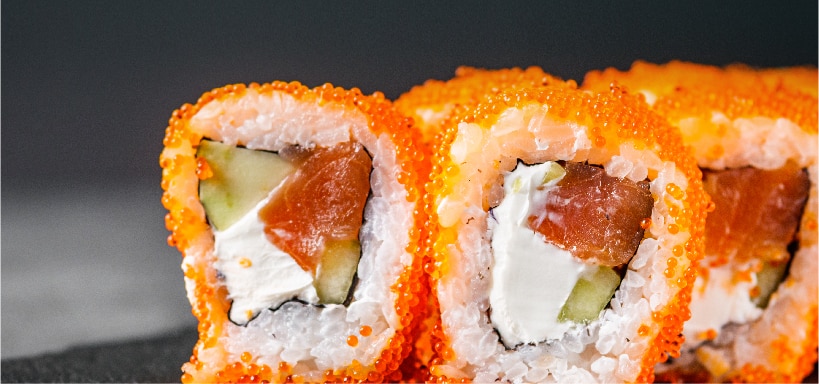Introduction to Masago
If you are a sushi enthusiast, chances are you have noticed tiny, bright orange pearls decorating your favorite sushi rolls. These small yet eye-catching eggs are known as masago, and while they may appear to be just a decorative topping, they play a far more important role in both flavor and culinary presentation. Masago delivers crunch, subtle saltiness, and visual appeal, making it a beloved ingredient in Japanese cuisine and beyond.
Over time, masago has grown in popularity worldwide, especially as sushi culture expanded outside Japan. Today, it is not only used in traditional dishes but also creatively incorporated into modern fusion recipes. Understanding masago allows food lovers to better appreciate the complexity and craftsmanship behind sushi.
Understanding Masago
Masago is the roe, or eggs, of the capelin fish, a small forage fish that thrives in extremely cold waters. These waters include the North Atlantic Ocean, North Pacific Ocean, and Arctic regions. Capelin fish play an important role in the marine ecosystem, and their roe has become a valued culinary ingredient.
Masago eggs are very small, usually about half the size of tobiko (flying fish roe). Their delicate structure gives them a light crunch rather than a hard pop, making them ideal for pairing with soft sushi rice and raw fish. This balance of textures is one of the main reasons masago is widely used by sushi chefs.
Origin and Natural Habitat of Capelin Fish
Capelin fish are schooling fish that live in cold, nutrient-rich waters. They migrate in large numbers during spawning season, which is when their roe is harvested. These fish are an essential food source for many larger marine animals, including whales, seals, and seabirds.
Because capelin are abundant and reproduce in large quantities, their roe is more affordable compared to other fish eggs such as caviar. This accessibility has helped masago become a staple ingredient in sushi restaurants around the world.
Culinary Importance of Masago
In Japanese cuisine, masago is appreciated for its versatility. It enhances dishes without overpowering other ingredients. Its mild flavor allows it to complement seafood, rice, vegetables, and sauces.
Masago is frequently used in sushi rolls, nigiri, and sashimi. However, it also appears in sauces, seafood salads, and modern fusion dishes. Chefs value masago not only for taste but also for its ability to improve presentation by adding bright color and texture.
How Masago Is Harvested
The harvesting of masago typically takes place during the capelin spawning season. Fishermen collect the fish responsibly to ensure that populations remain stable. Sustainable fishing practices are essential, as capelin are a vital part of ocean ecosystems.
After harvesting, the roe is carefully separated from the fish. This process requires precision to prevent damage to the eggs. Once extracted, the roe is immediately prepared for processing to maintain freshness.
Processing and Preservation of Masago
Once harvested, masago undergoes a cleaning process to remove impurities. The eggs are then lightly salted, which enhances flavor and acts as a natural preservative. In many cases, masago is seasoned with ingredients such as soy sauce or wasabi.
Naturally, masago is pale yellow in color. To improve visual appeal, it is often dyed orange or red using food-safe coloring. This coloring does not significantly affect taste but makes the roe more visually striking for sushi presentation.
Flavor Profile of Masago
Masago offers a mild yet satisfying taste. It is slightly salty, gently savory, and sometimes carries a faint hint of sweetness. Unlike stronger fish roes, masago does not overwhelm the palate.
Its texture is one of its most appealing qualities. Masago provides a light crunch rather than a sharp pop, creating contrast when paired with soft ingredients like rice, avocado, or raw fish. This textural balance enhances the overall dining experience.
Visual Appeal and Presentation
The vibrant orange color of masago makes it a favorite among sushi chefs. It adds brightness and contrast to rolls, making them more appetizing and visually dynamic.
Masago is often sprinkled on top of sushi rolls, mixed into fillings, or used as a garnish for plated dishes. Even a small amount can dramatically elevate the appearance of a dish, making it more appealing to diners.
Nutritional Benefits of Masago
Masago is not only flavorful but also nutritious. It contains high-quality protein, which supports muscle maintenance and overall health. It is also rich in omega-3 fatty acids, which are known to promote heart and brain health.
In addition, masago provides essential vitamins such as B12 and D. Vitamin B12 supports nerve function and energy production, while vitamin D contributes to bone health and immune support.
Calorie Content and Dietary Considerations
Masago is relatively low in calories, especially when used in small amounts. This makes it suitable for people who want to enjoy flavorful food without excessive calorie intake.
However, because masago is salted, individuals watching their sodium intake should consume it in moderation. When balanced properly, it can be a healthy addition to a well-rounded diet.
Popular Uses of Masago in Sushi
Masago is most commonly found in sushi rolls. It may be included inside the roll or sprinkled generously on top. Popular rolls often combine masago with ingredients such as crab, shrimp, cucumber, avocado, and spicy mayonnaise.
The roe enhances both flavor and texture, making each bite more complex and satisfying. Its subtle taste allows other ingredients to shine while still contributing its own character.
Use of Masago in Nigiri and Sashimi
In nigiri and sashimi, masago is often used as a garnish rather than a main ingredient. A small spoonful placed on top of fish or rice adds elegance and extra flavor.
This technique is especially common in upscale sushi presentations, where visual balance and refinement are essential.
Masago in Sauces and Modern Dishes
Beyond sushi, masago is frequently used in sauces and spreads. When mixed with mayonnaise, it creates a creamy, savory topping commonly served with seafood dishes.
Masago is also used in seafood salads, rice bowls, pasta dishes, and even Western fusion recipes. Its adaptability makes it a favorite ingredient among creative chefs.
Masago vs Tobiko: Key Differences
Masago is often confused with tobiko, another popular fish roe used in sushi. While both look similar, there are clear differences in size, texture, and flavor.
Tobiko comes from flying fish and is larger than masago. It has a firmer texture and a more pronounced crunch. Masago, on the other hand, is smaller, softer, and milder in taste.
Comparison Table: Masago vs Tobiko
| Feature | Masago | Tobiko |
|---|---|---|
| Fish Source | Capelin fish | Flying fish |
| Egg Size | Very small | Medium |
| Texture | Light crunch | Firm crunch |
| Flavor | Mild and slightly salty | Stronger and smoky |
| Price | More affordable | More expensive |
Buying Masago
Masago is widely available in Asian grocery stores, seafood markets, and specialty food shops. It is usually sold frozen or refrigerated in small containers.
When purchasing masago, look for roe that appears fresh, evenly colored, and free from excess liquid. High-quality masago should have a clean aroma and firm texture.
Storing Masago Properly
Once opened, masago should be stored in the refrigerator and consumed within a few days. Keeping it sealed tightly helps maintain freshness and prevents it from absorbing odors.
For long-term storage, masago can be frozen. When ready to use, it should be thawed slowly in the refrigerator rather than at room temperature to preserve its texture.
Cooking with Masago at Home
Masago is easy to incorporate into everyday cooking. It can be sprinkled over salads, rice bowls, or avocado toast for added flavor and texture.
Home cooks often enjoy using masago to enhance simple dishes, transforming them into restaurant-style meals with minimal effort.
Creative Uses of Masago
Creative cooks have found unique ways to use masago. It can be mixed into cream cheese for spreads, added to deviled eggs, or used as a topping for seafood pizzas.
Its versatility allows it to blend into both traditional and modern recipes, making it an exciting ingredient for experimentation.
Cultural Importance of Masago
In Japanese cuisine, attention to texture, balance, and presentation is essential. Masago fits perfectly within this philosophy by enhancing dishes without overpowering them.
As sushi continues to evolve globally, masago remains a symbol of craftsmanship and detail, appreciated by chefs and diners alike.
Conclusion
Masago is far more than a decorative garnish. Its mild flavor, satisfying crunch, nutritional benefits, and visual appeal make it a valuable ingredient in many cuisines.. From traditional sushi to modern fusion dishes, masago continues to captivate food lovers around the world.
The next time you enjoy sushi, those tiny orange eggs will no longer be a mystery. Instead, you’ll recognize them as an essential component that adds depth, balance, and beauty to the dish.







